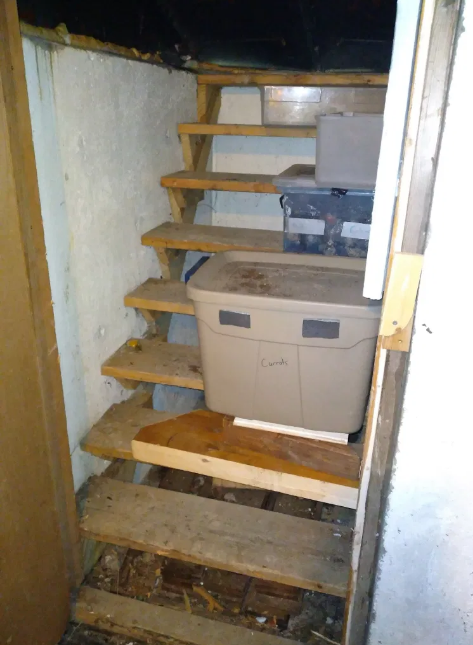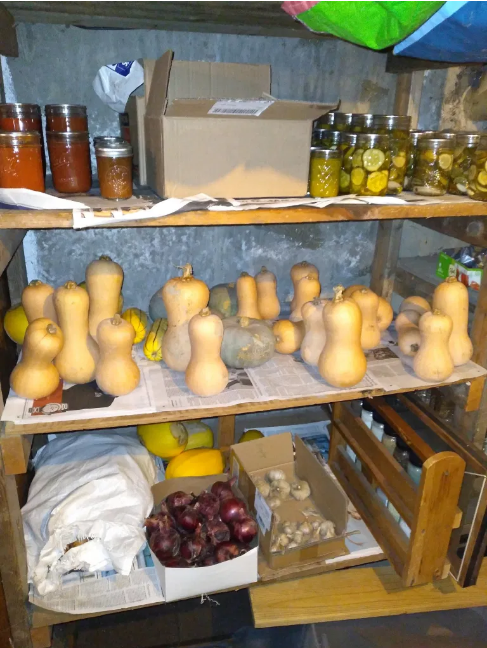Root cellars are great to help preserve some produce through the winter. When most people think of a root cellar, they picture a large underground room, often with an entrance somewhere in the yard separate from the house. But building a root cellar requires space and resources that are not always available to homeowners. Here are some simple solutions to that dilemma.
Jason Lilley, from the University of Maine Cooperative Extension, says, “As we cool temperatures respiration slows down and for root crops we keep our humidity high which prevents moisture loss. If you just think about the different climatic conditions around your house, you can find small spaces that are big enough to store whatever type of produce you may have in the ideal conditions for storage of those crops.”
Lilley said that there are a few different categories when it comes to produce that can be stored long term in root cellar-like conditions. First is produce that prefers cold temperatures, ideally between 33 and 35 degrees Fahrenheit, like carrots, parsnips and beets. The second category is produce that likes dry and warm conditions, like potatoes and winter squash. Finally, there is the category of produce that like a mid-range temperature, between 40 and 50 degrees, and dryer humidity, like onions and garlic. Once you know that, you can scope out different areas of your house that mimic those conditions of temperature and humidity. “You’re really trying to keep the temperature ranges in mind. Is it cool but not freezing, is it warm or is it that middle range of I want to have a sweatshirt?” 
Lilley found a sweet spot in his basement, around his furnace. “Next to the furnace that stays around 55 degrees and it’s pretty dry in the winter,” Lilley said. “That is where we leave our winter squash, or potatoes, and onions and garlic out in the open just in that space. We put the onions and garlic a little bit closer to the furnace than the potatoes and squash.
For cold-loving crops, he keeps them in the basement’s bulkhead. “That’s where we keep all our carrots and root crops,” Lilley said. “I put them in a Rubbermaid tote and put sand, wood chips or peat moss in with those crops and that will maintain the humidity really well throughout that season. Without it, they’d be a lot more likely to dry out essentially.” With this strategy, Lilley said you have to make sure your totes have ventilation.
“The produce also gives off certain gases that encourage produce to break down,” Lilley said. “We want to make sure those gasses can leave the space with the rubbermaid totes. I’ve cut little windows out of those and taped in some screening. That’s good enough to get that air flow.”
If you do not have extra space in your house, you can get even more creative by mimicking root cellar-like conditions by burying containers outside, though this only works for those crops that do not need extra dry conditions. You’re taking advantage of the ground temperature which is the key concept of the root cellar, whether it’s basement, out building or buried trash cans,” Lilley said.
He once experimented with burying clean, new trash cans in the ground and covering them with straw and leaves.
“When I wanted produce, I would go out, grab straw bales and move them out of the way and everything would be not frozen, but nice and cold,” Lilley said. The options for containers aren’t just limited to clean trash cans, either. Lilley said that he has seen people bury a number of things with built-in insulation, like coolers.
“As long as you do a really good job of removing the freon from a refrigerator, that can work well,” Lilley said. “Anything that has some level of insulation is really beneficial, in addition to insulation from straw bales of hay over the container to further insulate it.” However, Lilley said that the one thing he didn’t consider at the time was access. “When we got a little bit of snow, I was very reluctant to lay down on my belly in the snow and get a couple of carrots for dinner,” he said with a laugh. “It does work but you really want to think of your proximity, ease of use and how close that is to the kitchen.”
Lilley said one of the keys to troubleshooting your DIY root cellars is to make sure you are checking on them frequently as well as removing any compromised produce. “If you go down and you start to see that some of the crop is rotting or breaking down it’s really important to take those individual fruits or vegetables out of the bin,” Lilley said. “That will significantly slow down the spread of the breakdown. Keep an eye on what’s happening and make sure it keeps clean and keep notes on what’s working well and what isn’t.”
You also want to watch out for rodents. “Whenever you can elevate your storage off the ground and use some sort of preventative structure, that will go a long way to prevent rodents,” Lilley said.
“When you’re looking at your seed catalogs you really want to look for storage varieties of the different vegetables,” Lilley said. “That’s pretty key. Some varieties are designed to just mature quickly and they don’t necessarily set the skin or have the qualities that the produce needs to last for a long time in storage.”
Pay attention to how well your system works so you can improve next year. “You really want to pay attention to how well these crops are lasting,” Lilley said. “Maybe I should try a different space or a different type of container next year or maybe things work really well and I want to take records to remember what I did.”
There are advantages to these methods. It is cheaper, mobile and doesn’t take up as much space.
“To me it’s a convenience thing to walk down into my basement and to not even have to put on a sweatshirt to go grab that produce in the middle of February is really nice as opposed to having to keep a path snowblown all the way to the outbuilding all the way out to grab a few carrots for dinner,” Lilley said. “It’s one of those things that’s really fun to experiment with and it’s also just kind of rewarding to know we grew and harvested these crops.”
You can read the original article at bangordailynews.com

Hi Kelly,
Thanks for this article (and for all of the great info you share!)
I’ve read several posts here and on your greenbuilding blog about cool pantries and root cellars… I was wondering, if you keep a ventilated plastic bin of root veggies packed in damp sand or sawdust, will that help them keep as if in a root cellar, without raising the humidity in the pantry too much? We are attempting a cool pantry in our tire bale house…
Also, given the choice, do you think it would be better to let the pantry have a high ceiling so any heat rises (and the high portion could be used to store paper goods or other things that don’t need the cool), or to keep the ceiling low and insulated? Our walls will be made of tire bales (exterior to 8′) and scoria (interior walls and upper wall), and we will put an insulated door between the pantry and the kitchen. The front of the pantry will have a ~12′ ceiling. We could put a lower insulated ceiling and use the top as an attic if we need to to protect the pantry environment. Of course it would be easier and more accessible if we just have the tall ceiling and store warmer items high up…
I’m curious what you think. I think your cool pantry has a high domed ceiling, no?
Hi Kimi,
Damp sand is often advised for keeping such root veggies as carrots and beets, so I am sure what you suggest will help. Root cellars and pantries should generally have good ventilation, and a good way to arrange this is with a low fresh air inlet vent and a much higher exhaust vent. This arrangement might not provide the kind of warmer upper region that you want.
I have made a number of different root cellar/pantries, and two of them are described at http://greenhomebuilding.com/articles/pantries.htm and http://greenhomebuilding.com/articles/raincellar.htm . All of them have benefited from being substantially underground or bermed. It is tricky to combine both a humid root cellar and a drier pantry space; some compromises would need to be made. I suggest that you experiment and see what works for you.